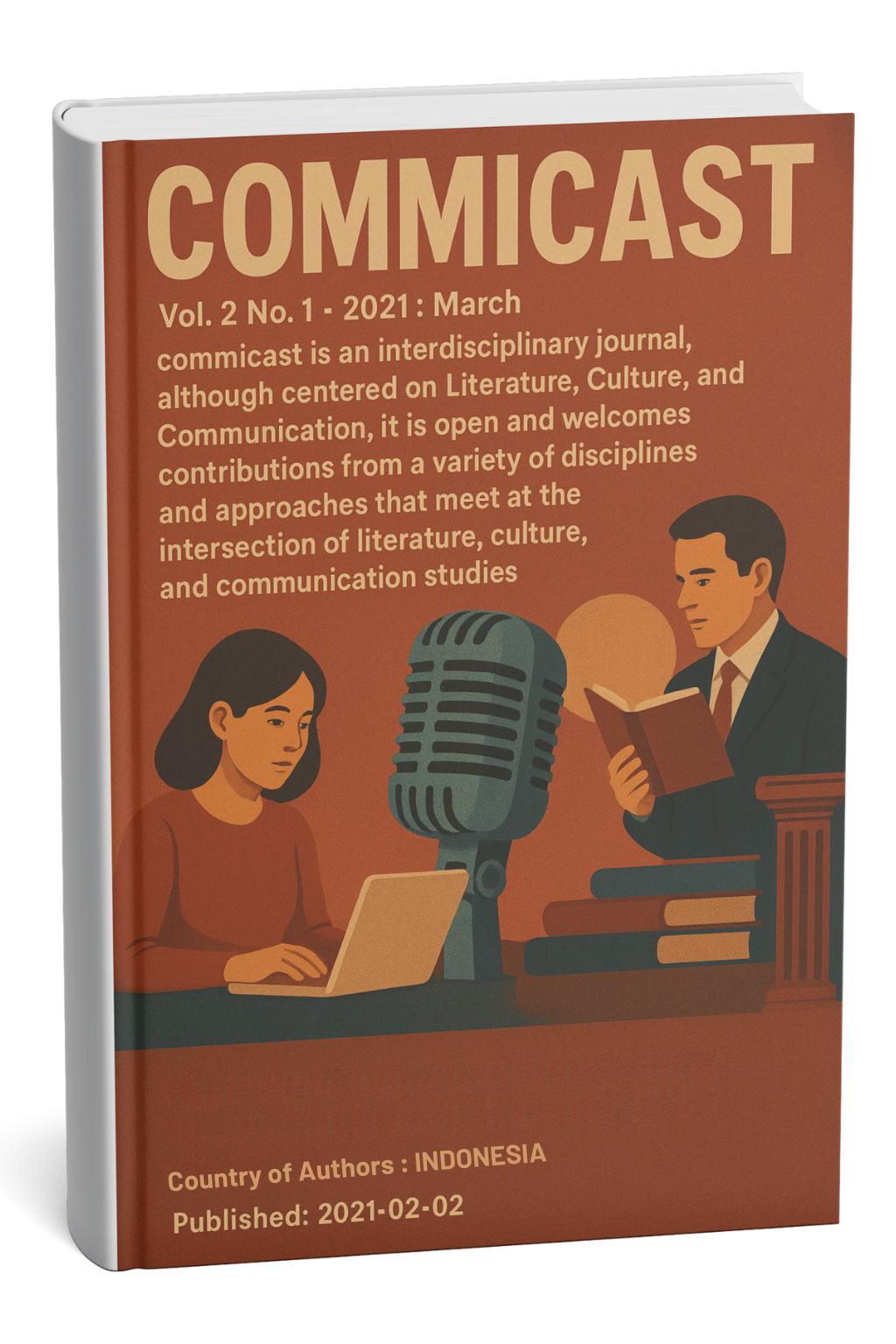Violation of justice in American police department as reflected in the film Changeling
DOI:
https://doi.org/10.12928/commicast.v2i1.2726Abstract
This undergraduate thesis describe justice theory and propaganda theory. This is aiming at analyzing violation of justice and propaganda police towards the main character and society in American. This undergraduate thesis has two main objectives to portray the violation of justice and the police propaganda in America as reflected in the Changeling film. This research uses descriptive qualitative method. There are two types of data in this study, they are primary and secondary data. The primary data is taken from the film Changeling and secondary data are taken from books, articles, journals, and data from network sources. In this research the, writer uses an interdisciplinary study. In conducting the analysis, researchers used the theory of justice and propaganda theory. To analyze this topic, the researcher uses John Rawls's theory of justice, which is actually contradict with what happens in this film. Then the researchers used propaganda theory from Jowett and O'Donnell, which the theory shows the behavior of the police against the main characters. The result of the study shows that is Los Angeles Police Department does not serve the society wisely. They use their power to be inappropriate. It acts in a violent way, and intimidates its citizens. The evil man are protected and the good is shot dead. Justice is not always run by violating people’s right. This research also finds that people who have been given a great power, they tend to abuse the power. Moreover, in human relationship, the concept of equal treatment must be applied to avoid conflicts. People who get unfair treatment tend to fight against the bad treatment. Everyone has rights to be treated equally. Upholding justice is not always done by violation their rights. This research also finds that fairly equal treatment is valuable. People should be treated equally in any condition.
References
Berg, N. (2014). Predicting crime, LAPD-style. The Guardian.
Hart, L. (2015). Social media. In Reputation Management: The Key to Successful Public Relations and Corporate Communication. https://doi.org/10.4324/9781315879987-12
Hoff, K., & Stiglitz, J. E. (2008). Exiting a lawless state. Economic Journal. https://doi.org/10.1111/j.1468-0297.2008.02177.x
Jowett, G. S., & O’Donnell, V. (2012). What Is Propaganda, and How Does It Differ From Persuasion? Propaganda and Persuasion.
Maguire, P., & Pitceathly, C. (2002). Key communication skills and how to acquire them. British Medical Journal. https://doi.org/10.1136/bmj.325.7366.697
Nasution, S. (2002). Metode Penelitian. Jakarta: Rineka Cipta.
Nieman, D. C., & Wentz, L. M. (2019). The compelling link between physical activity and the body’s defense system. Journal of Sport and Health Science. https://doi.org/10.1016/j.jshs.2018.09.009
Schneider, A. (2018). Fundamentals. In Springer Handbooks. https://doi.org/10.1007/978-3-662-55004-5_30
Downloads
Published
How to Cite
Issue
Section
License
License and Copyright Agreement
In submitting the manuscript to the journal, the authors certify that:
- They are authorized by their co-authors to enter into these arrangements.
- The work described has not been formally published before, except in the form of an abstract or as part of a published lecture, review, thesis, or overlay journal. Please also carefully read Commicast's Posting Your Article Policy at http://journal2.uad.ac.id/index.php/commicast/about/editorialPolicies#custom-5
- That it is not under consideration for publication elsewhere,
- That its publication has been approved by all the author(s) and by the responsible authorities – tacitly or explicitly – of the institutes where the work has been carried out.
- They secure the right to reproduce any material that has already been published or copyrighted elsewhere.
- They agree to the following license and copyright agreement.
Copyright
Authors who publish with Commicast agree to the following terms:
- Authors retain copyright and grant the journal right of first publication with the work simultaneously licensed under a Creative Commons Attribution License (CC BY-SA 4.0) that allows others to share the work with an acknowledgment of the work's authorship and initial publication in this journal.Â
- Authors are able to enter into separate, additional contractual arrangements for the non-exclusive distribution of the journal's published version of the work (e.g., post it to an institutional repository or publish it in a book), with an acknowledgment of its initial publication in this journal.
- Authors are permitted and encouraged to post their work online (e.g., in institutional repositories or on their website) prior to and during the submission process, as it can lead to productive exchanges, as well as earlier and greater citation of published work.
Licensing for Data Publication
Commicast use a variety of waivers and licenses, that are specifically designed for and appropriate for the treatment of data:
Open Data Commons Attribution License, http://www.opendatacommons.org/licenses/by/1.0/ (default)
Creative Commons CC-Zero Waiver, http://creativecommons.org/publicdomain/zero/1.0/
Open Data Commons Public Domain Dedication and Licence, http://www.opendatacommons.org/licenses/pddl/1-0/
Other data publishing licenses may be allowed as exceptions (subject to approval by the editor on a case-by-case basis) and should be justified with a written statement from the author, which will be published with the article.
Open Data and Software Publishing and Sharing
The journal strives to maximize the replicability of the research published in it. Authors are thus required to share all data, code or protocols underlying the research reported in their articles. Exceptions are permitted but have to be justified in a written public statement accompanying the article.
Datasets and software should be deposited and permanently archived inappropriate, trusted, general, or domain-specific repositories (please consult http://service.re3data.org and/or software repositories such as GitHub, GitLab, Bioinformatics.org, or equivalent). The associated persistent identifiers (e.g. DOI, or others) of the dataset(s) must be included in the data or software resources section of the article. Reference(s) to datasets and software should also be included in the reference list of the article with DOIs (where available). Where no domain-specific data repository exists, authors should deposit their datasets in a general repository such as ZENODO, Dryad, Dataverse, or others.
Small data may also be published as data files or packages supplementary to a research article, however, the authors should prefer in all cases a deposition in data repositories.























